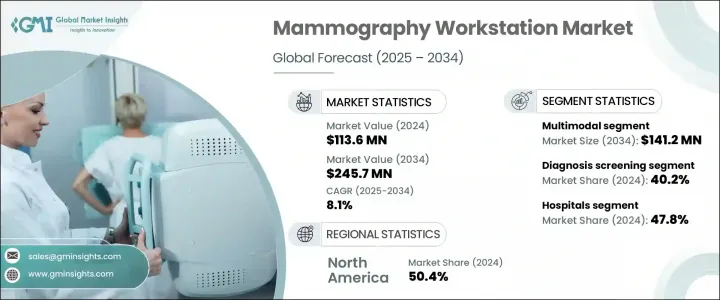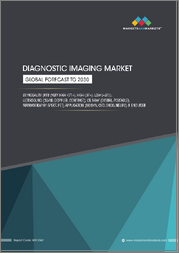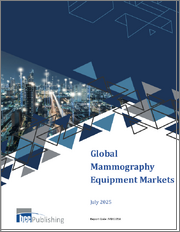
|
시장보고서
상품코드
1797790
맘모그래피 워크스테이션 시장 기회, 성장 촉진요인, 산업 동향 분석 및 예측(2025-2034년)Mammography Workstation Market Opportunity, Growth Drivers, Industry Trend Analysis, and Forecast 2025 - 2034 |
||||||
세계의 맘모그래피 워크스테이션 시장은 2024년에 1억 1,360만 달러로 평가되었고 CAGR 8.10%를 나타내 2034년에는 2억 4,570만 달러에 이를 것으로 예측되고 있습니다.
이 시장 확대의 주요 요인은 유방암 이환율 증가와 아날로그에서 디지털 맘모그래피 시스템으로의 급속한 전환입니다. 인공지능 대응 CAD 툴과 3D 토모신세시스 등의 첨단 이미지 기술의 통합으로 진단 워크플로우와 정밀도가 대폭 향상되었습니다. 헬스케어 인프라에 대한 공적·민간 투자는 세계적으로 증가하고 있으며, 정부의 지원에 의한 검진 이니셔티브는 특히 서비스가 깨끗한 신흥국 시장에서 확대되고 있습니다. 이러한 동향은 이 전문 분야의 세계 성장에 기여하고 있습니다.

맘모그래피 워크스테이션은 유방 진단의 핵심이 되는 영상 처리 플랫폼으로서 기능하며 방사선과 의사의 디지털 맘모그래피 검사의 검토, 분석 및 해석을 지원하기 위해 구축되었습니다. 고령화 사회가 세계적으로 진행되고 있는 가운데 조기 발견의 중요성이 높아짐에 따라 맘모그래피 워크스테이션과 같은 효율적인 진단 도구에 대한 수요가 높아지고 있습니다. 이러한 시스템은 현재 최신 이미징 센터의 필수적인 부분을 형성하고 있으며 방사선 기술자에게 유방 영상 검사를 더 빠르고 정확하게 해석하는 데 필요한 고급 기능을 제공합니다.
| 시장 범위 | |
|---|---|
| 시작 연도 | 2024년 |
| 예측 연도 | 2025-2034년 |
| 시작 금액 | 1억 1,360만 달러 |
| 예측 금액 | 2억 4,570만 달러 |
| CAGR | 8.1% |
2024년 멀티모달 워크스테이션 분야 시장 규모는 6,620만 달러로 평가되었고, 2034년에는 1억 4,120만 달러에 이를 것으로 예측됩니다. 이 부문의 인기는 여러 이미지 양식과의 호환성과 진단 기능의 향상 때문입니다. 병원과 진단센터는 합리화된 워크플로우, 인공지능 통합, 올인원 진단 환경을 지원하는 통합 플랫폼을 점점 더 요구하고 있으며, 이는 멀티모달 워크스테이션 부문을 강력한 페이스로 전진시키는 요인이 되고 있습니다.
2024년 진단 스크리닝 분야의 점유율은 40.2%였습니다. 이러한 시스템은 대량의 임상 현장에서의 요구에 부응하기 위해 개발되었으며 AI를 활용한 이미지 분석, 자동 병변 검출, 스크리닝 프로토콜과의 신속한 호환성 등의 기능을 갖추고 있습니다. 효율성을 위해 설계된 이러한 워크스테이션은 수작업 부담을 줄이고 진단의 턴어라운드를 가속화합니다. 정밀도를 유지하면서 대량의 환자 이미지를 처리할 수 있기 때문에 전국적인 스크리닝 활동이나 일상적인 진단에 필수적인 도구가 되고 있습니다.
북미의 맘모그래피 워크스테이션 시장은 2024년 50.4%의 점유율을 차지했습니다. 이 리더십은 확립된 건강 관리 시스템과 혁신적인 진단 기술의 채택에 대한 강한 지향 때문입니다. 미국과 캐나다의 유방암 이환율 상승은 진단 인프라에 대한 많은 투자와 함께 이 지역의 성장을 뒷받침하고 있습니다. 북미에서는 하이엔드 진단 툴의 개발이 진행되고 있는 것도 시장의 우위성을 유지하는 요인이 되고 있습니다.
세계의 맘모그래피 워크스테이션 시장을 형성하는 주요 기업은 코니카 미놀타 비즈니스 솔루션 인디아, 홀로직, 지멘스 헤르티니어스, Philips 헬스 케어, 아스트림 헬스, 섹트라, 애널로직, 아그파 게발트 그룹, GE 헬스케어, 아이칸 메디컬 시스템즈, 메데콤, 메탈트로니카, EIZO, 후지필름 등이 있습니다. 이러한 기업들은 이 분야의 기술적 진화와 세계 전개에 계속 영향을 미치고 있습니다. 맘모그래피 워크스테이션 시장 주요 기업은 인공지능, 3D 이미징, 딥러닝 알고리즘을 자사의 플랫폼에 통합하여 진단 정밀도를 높임으로써 적극적인 혁신 전략을 추구하고 있습니다. 지멘스 헬티니어스, GE 헬스케어, 홀로직 등의 기업들은 R&D에 많은 투자를 하고 있으며 공공 및 민간 의료 부문을 위한 기능이 풍부한 멀티모달 시스템을 출시하고 있습니다. 병원이나 진단 체인과의 제휴를 통해 풋 프린트를 확대함으로써 제품의 보급을 촉진하고 있습니다. 또, 많은 기업이 생산·유통망의 현지화를 진행해, 액세스의 향상과 리드 타임의 단축을 도모하고 있습니다.
목차
제1장 조사 방법과 범위
제2장 주요 요약
제3장 업계 인사이트
- 생태계 분석
- 업계에 미치는 영향요인
- 성장 촉진요인
- 세계적으로 유방암 발생률이 상승
- 조기 발견에 대한 의식의 고조
- 고령자 인구 증가
- 업계의 잠재적 위험 및 과제
- 고급 워크스테이션 시스템의 고비용
- 저소득지역 및 농촌지역에서는 접근이 제한
- 시장 기회
- 지속적인 기술 개선
- 정부의 검사 프로그램의 급증
- 성장 촉진요인
- 성장 가능성 분석
- 규제 상황
- 기술적 진보
- 현재의 기술 동향
- 신흥기술
- 공급망 분석
- 상환 시나리오
- 가격 분석(2024년)
- 향후 시장 동향
- 갭 분석
- Porter's Five Forces 분석
- PESTEL 분석
제4장 경쟁 구도
- 서론
- 기업의 시장 점유율 분석
- 기업 매트릭스 분석
- 주요 시장 기업의 경쟁 분석
- 경쟁 포지셔닝 매트릭스
- 주요 발전
- 합병과 인수
- 파트너십 및 협업
- 신제품 발매
- 확장 계획
제5장 시장 추계·예측 : 모달리티별(2021-2034년)
- 주요 동향
- 멀티모달
- 독립형
제6장 시장 추계·예측 : 용도별(2021-2034년)
- 주요 동향
- 진단 스크리닝
- 고급 이미징
- 임상 검토
- 모발 샘플
제7장 시장 추계·예측 : 최종 용도별(2021-2034년)
- 주요 동향
- 병원
- 전문 클리닉
- 기타 용도
제8장 시장 추계·예측 : 지역별(2021-2034년)
- 주요 동향
- 북미
- 미국
- 캐나다
- 유럽
- 독일
- 영국
- 프랑스
- 스페인
- 이탈리아
- 네덜란드
- 아시아태평양
- 중국
- 인도
- 일본
- 호주
- 한국
- 라틴아메리카
- 브라질
- 멕시코
- 아르헨티나
- 중동 및 아프리카
- 사우디아라비아
- 남아프리카
- 아랍에미리트(UAE)
제9장 기업 프로파일
- Agfa-Gevaert Group
- Analogic
- aycan Medical Systems
- Carestream Health
- EIZO
- Fujifilm
- GE Healthcare
- Hologic
- Konica Minolta Business Solutions India
- Medecom
- Metaltronica
- Phillips Healthcare
- Sectra
- Siemens Healthineers
The Global Mammography Workstation Market was valued at USD 113.6 million in 2024 and is estimated to grow at a CAGR of 8.10% to reach USD 245.7 million by 2034. This expansion is largely fueled by the increasing incidence of breast cancer and the rapid shift from analog to digital mammography systems. The integration of advanced imaging technologies, such as artificial intelligence-enabled CAD tools and 3D tomosynthesis, is significantly improving diagnostic workflows and accuracy. Public and private investments in healthcare infrastructure are increasing worldwide, and government-backed screening initiatives are expanding, particularly in underserved and developing markets. These trends are collectively contributing to the global growth of this specialized segment.

A mammography workstation functions as a core imaging platform in breast diagnostics, built to assist radiologists with reviewing, analyzing, and interpreting digital mammography scans. With the aging population continuing to rise globally, the demand for efficient diagnostic tools like mammography workstations is growing as early detection becomes increasingly important. These systems now form an essential part of modern imaging centers, offering radiologists the advanced functionality needed for faster and more precise interpretation of breast imaging studies.
| Market Scope | |
|---|---|
| Start Year | 2024 |
| Forecast Year | 2025-2034 |
| Start Value | $113.6 Million |
| Forecast Value | $245.7 Million |
| CAGR | 8.1% |
In 2024, the multimodal workstation segment was valued at USD 66.2 million and is estimated to reach USD 141.2 million by 2034. The popularity of this segment is due to its compatibility with multiple imaging modalities and enhanced diagnostic capabilities. Hospitals and diagnostic centers are increasingly seeking integrated platforms that support streamlined workflows, artificial intelligence integration, and all-in-one diagnostic environments-factors that are helping drive the multimodal workstation segment forward at a strong pace.
The diagnosis screening segment held a 40.2% share in 2024. These systems are developed to meet the demands of high-volume clinical settings and come equipped with features like AI-enhanced image analysis, automated lesion detection, and quick compatibility with screening protocols. Designed for efficiency, these workstations reduce manual workload and accelerate diagnostic turnaround, which is critical in public healthcare programs and high-throughput hospital environments. Their ability to handle a large volume of patient images while maintaining accuracy has made them essential tools in national screening efforts and routine diagnostics.
North America Mammography Workstation Market held a 50.4% share in 2024. This leadership is attributed to a well-established healthcare system and a strong inclination toward adopting innovative diagnostic technologies. Rising breast cancer rates in both the U.S. and Canada, coupled with significant investments in diagnostic infrastructure, continue to push the region's growth. The ongoing development of high-end diagnostic tools in North America also contributes to maintaining its dominant market position.
Major players shaping the Global Mammography Workstation Market include Konica Minolta Business Solutions India, Hologic, Siemens Healthineers, Philips Healthcare, Carestream Health, Sectra, Analogic, Agfa-Gevaert Group, GE Healthcare, Aycan Medical Systems, Medecom, Metaltronica, EIZO, and Fujifilm. These companies continue to influence technological evolution and global reach within the sector. Leading companies in the mammography workstation market are pursuing aggressive innovation strategies by integrating artificial intelligence, 3D imaging, and deep learning algorithms into their platforms to enhance diagnostic precision. Firms like Siemens Healthineers, GE Healthcare, and Hologic are investing heavily in R&D to launch feature-rich, multimodal systems tailored for both public and private health sectors. Expanding their footprint through partnerships with hospitals and diagnostic chains helps increase product adoption. Many players are also localizing production and distribution networks to improve accessibility and reduce lead times.
Table of Contents
Chapter 1 Methodology and Scope
- 1.1 Market scope and definition
- 1.2 Research design
- 1.2.1 Research approach
- 1.2.2 Data collection methods
- 1.3 Data mining sources
- 1.3.1 Global
- 1.3.2 Regional/Country
- 1.4 Base estimates and calculations
- 1.4.1 Base year calculation
- 1.4.2 Key trends for market estimation
- 1.5 Primary research and validation
- 1.5.1 Primary sources
- 1.6 Forecast model
- 1.7 Research assumptions and limitations
Chapter 2 Executive Summary
- 2.1 Industry 360° synopsis
- 2.2 Key market trends
- 2.2.1 Regional trends
- 2.2.2 Modality trends
- 2.2.3 Application trends
- 2.2.4 End use trends
- 2.3 CXO perspectives: Strategic imperatives
- 2.3.1 Key decision points for industry executives
- 2.3.2 Critical success factors for market players
- 2.4 Future outlook and strategic recommendations
Chapter 3 Industry Insights
- 3.1 Industry ecosystem analysis
- 3.2 Industry impact forces
- 3.2.1 Growth drivers
- 3.2.1.1 Rising incidence of breast cancer globally
- 3.2.1.2 Increase in awareness of early detection
- 3.2.1.3 Expanding elderly population
- 3.2.2 Industry pitfalls and challenges
- 3.2.2.1 High cost of advanced workstation systems
- 3.2.2.2 Limited access in low-income and rural regions
- 3.2.3 Market opportunities
- 3.2.3.1 Ongoing technology improvements
- 3.2.3.2 Surge in government screening programs
- 3.2.1 Growth drivers
- 3.3 Growth potential analysis
- 3.4 Regulatory landscape
- 3.5 Technological advancements
- 3.5.1 Current technological trends
- 3.5.2 Emerging technologies
- 3.6 Supply chain analysis
- 3.7 Reimbursement scenario
- 3.8 Pricing analysis, 2024
- 3.9 Future market trends
- 3.10 Gap analysis
- 3.11 Porter's analysis
- 3.12 PESTEL analysis
Chapter 4 Competitive Landscape, 2024
- 4.1 Introduction
- 4.2 Company market share analysis
- 4.3 Company matrix analysis
- 4.4 Competitive analysis of major market players
- 4.5 Competitive positioning matrix
- 4.6 Key developments
- 4.6.1 Mergers and acquisitions
- 4.6.2 Partnerships and collaborations
- 4.6.3 New product launches
- 4.6.4 Expansion plans
Chapter 5 Market Estimates and Forecast, By Modality, 2021 - 2034 ($ Mn)
- 5.1 Key trends
- 5.2 Multimodal
- 5.3 Standalone
Chapter 6 Market Estimates and Forecast, By Application, 2021 - 2034 ($ Mn)
- 6.1 Key trends
- 6.2 Diagnosis screening
- 6.3 Advance imaging
- 6.4 Clinical review
- 6.5 Hair samples
Chapter 7 Market Estimates and Forecast, By End Use, 2021 - 2034 ($ Mn)
- 7.1 Key trends
- 7.2 Hospitals
- 7.3 Specialty clinics
- 7.4 Other end use
Chapter 8 Market Estimates and Forecast, By Region, 2021 - 2034 ($ Mn)
- 8.1 Key trends
- 8.2 North America
- 8.2.1 U.S.
- 8.2.2 Canada
- 8.3 Europe
- 8.3.1 Germany
- 8.3.2 UK
- 8.3.3 France
- 8.3.4 Spain
- 8.3.5 Italy
- 8.3.6 Netherlands
- 8.4 Asia Pacific
- 8.4.1 China
- 8.4.2 India
- 8.4.3 Japan
- 8.4.4 Australia
- 8.4.5 South Korea
- 8.5 Latin America
- 8.5.1 Brazil
- 8.5.2 Mexico
- 8.5.3 Argentina
- 8.6 Middle East and Africa
- 8.6.1 Saudi Arabia
- 8.6.2 South Africa
- 8.6.3 UAE
Chapter 9 Company Profiles
- 9.1 Agfa-Gevaert Group
- 9.2 Analogic
- 9.3 aycan Medical Systems
- 9.4 Carestream Health
- 9.5 EIZO
- 9.6 Fujifilm
- 9.7 GE Healthcare
- 9.8 Hologic
- 9.9 Konica Minolta Business Solutions India
- 9.10 Medecom
- 9.11 Metaltronica
- 9.12 Phillips Healthcare
- 9.13 Sectra
- 9.14 Siemens Healthineers



















